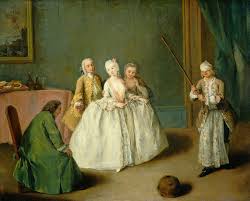Contemporary fashionistas can learn many things from crazy fashion trends in history. The first is that people can go to ridiculous lengths to show their high status in society, all in the name of fashion. This could involve them wearing high heels, stifling corsets that could change the position of their organs or skirts that could hobble them. The second thing is that the key to becoming a fashionable person is an exaggeration. The true devotees of trends believed that the more exaggerated the item of clothing, the better it was to appear fashionable.
The strange fashion trends in history were often dangerous too. Various dyes were made with a toxic chemical like arsenic, while big crinolines were very flammable. Even if the clothing wasn’t dangerous, it impeded a person’s ability to live a normal life. Those who wore bliauts couldn’t use their arms, men who put on crakowes found walking difficult, while women who wore wide panniers prevented women from fitting in narrow doors. Listed below are 7 such trends:
- Lotus Shoes
Lotus shoes were worn by Chinese girls with bound feet. For many centuries, Chinese families broke and folded the feet of their daughters to create tiny feet which indicated femininity. The feet were bound using long ribbons to prevent their growth. The process took two to three years, and the girl’s feet were bound for the entirety of her life. Women with bound feet wore lotus shoes or cone-shaped footwear that resembled lotus buds. These shoes were made of silk or cotton, and were generally embroidered with flowers, animals, and other traditional designs. There were many attempts to ban the practice of foot binding in China. It was outlawed in China after the revolution against the Qing dynasty resulted in the formation of a republic. However, it was still carried out in some areas of the country for many years afterward.

- Arsenic Dresses
In the Victorian Era, dresses of the bottle-green color were a prominent fashion. They also cost a lot. To bring out this shade of the green color, large amounts of arsenic were used. Some women suffered from nausea, impaired vision, and skin allergy to the dye. But these dresses were worn only on special occasions. Hence women’s exposure to the arsenic in the fabric was limited. The people who really suffered as a result of the arsenic were the makers of these garments. Many of them died due to exposure to arsenic during the manufacturing process.
- Macaroni
During the 1760s, aristocratic British men used to wear large wigs with a small hat or feather at the top of the wig. The wigs were worn mostly by young men, who had reportedly brought the trend back from their tours of Continental Europe, wherein they had intended to increase the level of their cultural knowledge about the Continent’s diverse cultures. The style is actually named after an Italian pasta dish, which denoted urbanity and refinement. A rhyme about Macaroni was meant to parody the idea that any common person could stick a feather in his hair and consider himself as valuable as ‘macaroni’. However, the style became a trend and extended into the following decade.

4. Crakowes
The Crakowes, also known as ‘poulaine’ was a kind of long shoe which were popular across Europe during the latter part of the 14th century. The shoes were named after the Polish city of Krakow because they were introduced in England by Polish nobility. The shoes became famous once they were introduced in the English court. This even though the shoes were six to twenty-four inches in length. They were the indicators of social status. The longer the shoes were, the higher was the wearer’s status. Sometimes, chains were attached to the toe of the crakow or they were stuffed to enable the person wearing it to walk properly. The shoes were considered farcical, arrogant, and threatening by many conservative and church leaders. The latter referred to them as ‘devil’s fingers’.
- Panniers
The word ‘Pannier’ deriving from the French word ‘Panier’, meaning ‘Basket’ was a fashion trend that was popular in the 17th and 18th centuries. It was a kind of boxed petticoat which expanded the width of skirts and dresses and stood out on either side of the waistline. Panniers were available in different sizes and were mostly made of wood, whalebone, metal, reeds, etc. They were worn on select occasions and reflected the social status of the one wearing them. While wearing them, two noblewomen couldn’t walk through a door at the same time or sit on a couch together. It was also uncomfortable as it limited the movement and activity of the wearer. It also sparked ridicule with fashion magazines written in 1750 portraying women as being sick of using it.

- Chopines
Noblewomen in the 16th century were very interested in shoes known as chopines. They were generally made of wood or cork and covered in leather, brocade, or jewel-embroidered velvet. They were also a signifier of a person’s social status with higher shoes meaning a higher status. Chopines made the women wearing them wobbly on their feet and having to require help to walk in these extra tall shoes.
- Bombasts
Bombasts were large body stuffing that was popular with both men and women during the 16th century. Bombasts typically included cotton, wool, or sawdust being used to add volume to specific areas of clothing like sleeves. Men sometimes filled their doublets to give an impression of a larger belly or padded their calf muscles to look more muscular.











